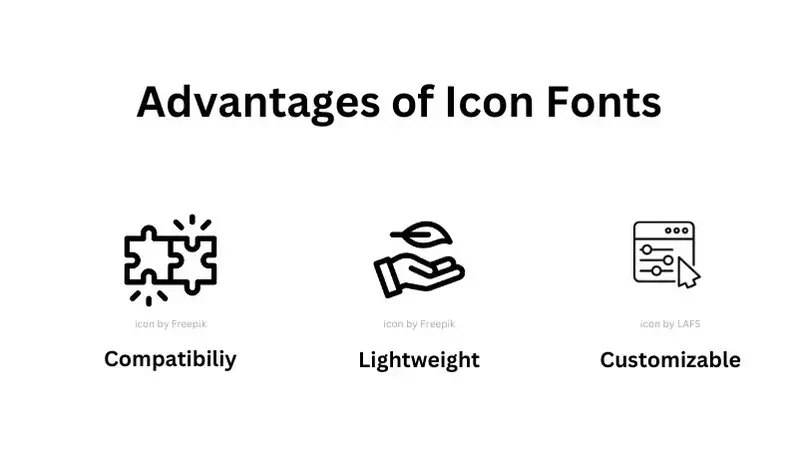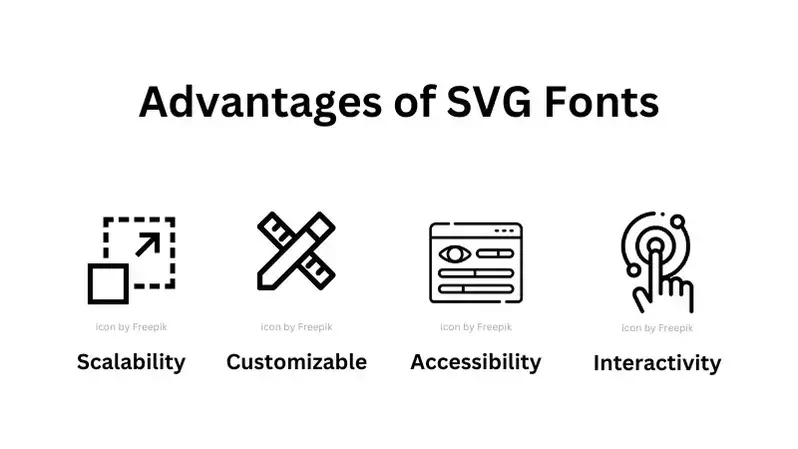In the realm of web design, icons play a crucial role in enhancing user experience and visual appeal. They provide a quick and intuitive way to convey information and guide users through a website. When it comes to implementing icons, two primary methods stand out: icon fonts and SVG (Scalable Vector Graphics). Each approach has its advantages and drawbacks, making it essential to understand their differences and choose the most suitable option for your specific needs.
Icon Fonts
Icon fonts are essentially font files that contain glyphs representing various icons. These glyphs are embedded into the HTML code, allowing them to be styled and rendered like text characters. Popular icon font libraries include Font Awesome, Glyphicons, and Material Icons.
Advantages of Icon Fonts

Compatibility
Icon fonts offer a high degree of compatibility across various browsers, ensuring that your icons will display correctly on most devices. This broad support is a significant advantage, as it reduces the likelihood of compatibility issues and ensures a consistent user experience for your website visitors.
Additionally, icon fonts are often pre-installed on many devices, which can further improve their compatibility and performance. This means that your website will load faster and display icons more reliably without requiring additional font downloads.
Lightweight
Compared to SVGs, icon fonts typically have a smaller file size, leading to faster page load times. This is because icon fonts are essentially compressed collections of glyphs, while SVGs are vector-based images that contain more detailed information about each shape and path. As a result, icon fonts can often be transmitted over the network more efficiently, resulting in quicker page rendering and a better overall user experience.
Customizable
You can easily change the color, size, and other properties of icon fonts using CSS styles. Simply use CSS classes to reference specific icons within your HTML code. For example, to display a Font Awesome icon for a search function, you would simply use the following HTML:
HTML
<i class="fa fa-search"></i>
This code snippet tells the browser to render the "search" icon from the Font Awesome library. You can customize the appearance of the icon by applying CSS styles to the element. For instance, to change the color of the icon, you could use the following CSS:
CSS
.fa-search {
color: blue;
}
This would make the search icon appear blue on the page.
Disadvantages of Icon Fonts
Limited flexibility
Icon fonts are less flexible than SVGs when it comes to customization. You may encounter limitations in terms of gradient effects, transparency, and complex shapes, which can restrict your ability to create highly detailed or visually striking icons.
Font weight issues
If you use multiple icon fonts with different weights (e.g., regular, bold, italic), it can increase the overall file size and complexity of your project. This is because each font weight essentially represents a separate set of glyphs, which can lead to larger file sizes and potential performance issues.
Accessibility concerns
While icon fonts are generally accessible, ensuring proper screen reader support might require additional effort. This is because screen readers may not always recognize icon fonts as images, and you may need to provide additional context or descriptions to make them accessible to users with visual impairments.
Examples of Icon Fonts on the Web
Icon fonts have become a ubiquitous tool in web design, enhancing user experience and visual appeal across a wide range of websites. Here are some prominent examples of their application:
Social Media Platforms:
Facebook uses a custom icon font to represent various social actions, such as like, comment, share, and more. The consistent use of these icons throughout the platform creates a cohesive and recognizable visual language.
Twitter employs a custom icon font for its core functions, including tweet, retweet, favorite, and direct message. The simplicity and clarity of these icons contribute to the platform's intuitive user interface.
E-commerce Websites:
- Amazon
Amazon utilizes a custom icon font for various shopping functions, including add to cart, wishlist, and customer reviews. The clear and concise icons help users navigate the website efficiently.
- eBay
eBay uses a custom icon font to represent actions like watch, bid, and buy it now. The consistent use of these icons throughout the platform creates a familiar and user-friendly experience.
- Shopify
Shopify offers a built-in icon font library that can be used to customize the appearance of online stores. This allows merchants to create a unique and visually appealing shopping experience.
Content Management Systems (CMS):
- WordPress
WordPress includes a built-in icon font library known as Dashicons, which is used throughout the admin interface. This provides a consistent and visually appealing experience for website administrators.
- Drupal
Drupal also offers a built-in icon font library called Core UI Icons, which is used in the admin interface and can be integrated into custom themes.
Design and Development Tools:
- Bootstrap
Bootstrap comes bundled with a comprehensive icon font library known as Glyphicon. This library provides a wide range of icons that can be easily integrated into Bootstrap-based projects.
- Foundation
Foundation also includes a built-in icon font library, offering a variety of icons for use in responsive web design projects.
SVG Fonts
SVG fonts are a type of font format that utilizes Scalable Vector Graphics (SVG) technology to represent glyphs (characters). Unlike traditional bitmap fonts, SVG fonts are resolution-independent, meaning they can be scaled to any size without losing quality. This makes them ideal for responsive designs and ensures that icons and text always look sharp and clear on different devices.
Advantages of SVG Fonts

Scalability
SVG fonts are exceptionally scalable, meaning they can be resized without losing their quality or clarity. This is a significant advantage for responsive designs, where content must adapt to various screen sizes and resolutions. Unlike raster images, which can become pixelated when enlarged or reduced, SVG fonts maintain their sharpness and crispness regardless of their dimensions.
Customizable
SVG fonts offer a level of customization that is unmatched by other icon formats. You have complete control over every aspect of your icons, from their color and size to their gradients, effects, and even their underlying shapes. This flexibility allows you to create unique and visually striking icons that perfectly align with your design vision.
Accessibility
Accessibility is a critical consideration in modern web design, and SVG fonts excel in this regard. They are inherently accessible, as they can be styled and described using CSS and ARIA attributes. This makes them compatible with screen readers and other assistive technologies, ensuring that your icons are usable by people with disabilities.
Interactivity
SVG fonts are not limited to static images; they can also be made interactive using JavaScript. This opens up a world of possibilities for creating dynamic and engaging user experiences. For example, you can create hover effects that change the color or size of an icon when the user hovers over it, or you can animate icons to draw attention to specific elements on your page.
Disadvantages of SVG Fonts
File Size
SVG fonts can sometimes be larger than traditional bitmap fonts, especially for complex icons or when using many different colors. This can impact page load times, particularly on slower connections.
Compatibility Issue
While SVG support has improved significantly in recent years, there might still be compatibility issues with older browsers or specific devices. This can lead to inconsistent rendering of icons or even prevent them from displaying altogether.
Complexity
Creating and editing SVG fonts can be more complex than working with traditional bitmap fonts, requiring a basic understanding of XML and vector graphics. This can increase the development time and learning curve for designers and developers.
Examples of SVG Fonts on the Web
SVG fonts have gained popularity in recent years due to their flexibility and scalability. Here are some notable examples of websites that utilize SVG fonts:
Social Media Platforms:
- Dribbble
Dribbble, a popular platform for sharing design work, uses SVG fonts for its interface icons, providing a clean and professional look.
- Behance
Behance, another platform for showcasing design work, also employs SVG fonts for its interface elements, ensuring a consistent and visually appealing experience.
E-commerce Websites:
- Airbnb
Airbnb uses SVG fonts for its property icons and other visual elements, allowing them to scale seamlessly across different devices and resolutions.
- Booking.com
Booking.com also leverages SVG fonts for its interface icons, ensuring a consistent and modern look across the platform.
Content Management Systems (CMS):
- Ghost
Ghost, a popular blogging platform, uses SVG fonts for its interface icons, providing a modern and user-friendly experience.
- Hugo
Hugo, a static site generator, often includes SVG fonts in its themes, offering a visually appealing and scalable design.
Design and Development Tools:
- Adobe XD
Adobe XD, a popular design tool, uses SVG fonts for its interface icons, ensuring they remain crisp and scalable across different screen sizes.
- Sketch
Sketch, another popular design tool, also employs SVG fonts for its interface elements, providing a consistent and visually appealing user experience.
Choosing the Right Approach
The decision between icon fonts and SVG fonts depends on several factors, including:
- Complexity of the icons
For simple icons with basic shapes and colors, icon fonts are often a good choice due to their smaller file size and ease of use. However, for more complex icons with gradients, transparency, or intricate details, SVG fonts offer greater flexibility and customization options.
- Performance considerations
While icon fonts typically have a smaller file size, the difference in performance may be negligible in many cases, especially with modern browsers and efficient website optimization. If page load time is a critical factor, it's essential to test both options to determine the best approach for your specific project.
- Accessibility requirements
Both icon fonts and SVG fonts can be made accessible, but SVG fonts often have an inherent advantage due to their vector nature, which makes them more compatible with screen readers and other assistive technologies. If accessibility is a priority, SVG fonts may be the preferred choice.
- Level of customization
If you need a high degree of customization for your icons, SVG fonts are the way to go. They offer greater flexibility in terms of styling options, allowing you to create unique and visually appealing designs. Icon fonts, while still customizable, may have limitations in certain areas.
- Browser compatibility
If you need to support older browsers, you may need to consider the browser compatibility of SVG fonts. While SVG support has improved significantly in recent years, there might still be compatibility issues with older browsers or specific devices. In such cases, icon fonts may be a more reliable option.
Icon Fonts vs SVG
| Feature | Icon Fonts | SVG Fonts |
|---|---|---|
| Scalability | Limited (can become pixelated when scaled) | Highly scalable, maintains quality at any size |
| Customization | Moderate (can change color, size, etc.) | Extensive (can customize every aspect, including gradients, and effects) |
| File size | Generally smaller | Can be larger, especially for complex icons |
| Compatibility | Wide browser support | May have compatibility issues with older browsers |
| Performance | Typically faster page load times | Can impact performance for complex icons |
| Accessibility** | Generally accessible | Inherently accessible |
| Interactivity | Limited | Can be made interactive using |
| JavaScript | ||
| Complexity | Easy to use | Can be more complex to create and edit |
| Best use cases | Simple icons, basic customization, fast page load times | Complex icons, high customization, responsive designs, accessibility |
Conclusion
Both icon fonts and SVGs have their own strengths and weaknesses. The best approach for your project will depend on your specific needs and priorities. By carefully considering the factors discussed in this article, you can make an informed decision and select the method that will best serve your design goals.
Frequently Asked Questions
How secure are free HTML editors?
Free HTML editors are generally secure, but it's essential to download them from reputable sources to avoid potential risks.
Can I host multimedia content on an HTML website?
Yes, you can host multimedia content like images, videos, and audio on an HTML site. Ensure your hosting plan has sufficient storage and bandwidth to handle such content efficiently.
How do I add custom fonts or icons to my WordPress theme?
Enqueue custom fonts using wp_enqueue_style, and integrate icons using icon fonts or SVGs, ensuring proper licensing and performance optimization.
What are the best practices for responsive design in WordPress themes?
Use a mobile-first approach, implement media queries, test across various devices, and prioritize user experience on both desktop and mobile.

Audee Mirza is a graphic designer and WordPress developer at audeemirza.com who resides in Surabaya, Indonesia. She's also the author of Graphic Identity Blog, a professional logo designer, and often creates vector illustrations for clients and marketplaces. She enjoys good typography design and all kinds of animation.
View all posts by Audee Mirza




















